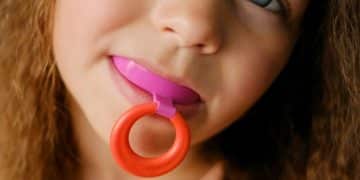Safe teething toys for babies: your guide to comfort

Safe teething toys for babies are essential for soothing discomfort during teething, and they should be made from non-toxic materials, age-appropriate, and free from small parts to ensure safety.
Finding safe teething toys for babies is crucial for their comfort during this challenging phase. Have you ever wondered what options can truly soothe your little one? Let’s explore the best choices together.
What makes a teething toy safe?
Understanding what makes a teething toy safe is crucial for parents looking to help their babies through the discomfort of teething. With the right choices, you can ensure that your baby’s experience is not only less painful but also safe.
Materials Matter
The materials used in teething toys directly impact their safety. Always look for products made from:
- BPA-free plastic
- Natural rubber
- Silicone
- Wood from non-toxic sources
These safe materials can withstand chewing and gnawing, ensuring your baby is not exposed to harmful substances.
Choking Hazards
Another important aspect is avoiding potential choking hazards. Teething toys should be:
- Large enough to prevent swallowing
- Free from small parts that could break off
- Soft enough for gentle chewing
Keep an eye out for these factors when selecting toys to ensure they are appropriate for your baby’s age.
Design is also vital. A teething toy should have a design that encourages safe handling. Look for features like rounded edges and textured surfaces. These elements not only cater to a baby’s natural chewing instincts but also help soothe sore gums effectively.
Cleaning and Maintenance
Keeping teething toys clean is essential for your child’s health. Opt for toys that are:
- Easy to clean and maintain
- Dishwasher safe or can be sterilized
- Made from materials that resist bacteria
Regular cleaning not only ensures safety but also maximizes the lifespan of the toy.
All in all, picking a safe teething toy means considering materials, size, design, and maintenance. By being informed, you can choose toys that not only keep your baby comfortable but also ensure their safety during this important developmental stage.
Top materials for baby teething toys
Choosing the right materials for baby teething toys is essential for both safety and comfort. Parents want to ensure that their little ones have toys that are not only fun but also effective in soothing sore gums.
Natural Rubber
Natural rubber is a popular choice for many teething toys. It is soft and flexible, which makes it gentle on a baby’s gums. Plus, it is biodegradable, making it an eco-friendly option.
Silicone
Silicone is another fantastic material for teething toys. It is durable, easy to clean, and free from harmful chemicals. Silicone toys come in various textures, providing babies with an engaging sensory experience.
BPA-Free Plastic
When looking for durable options, BPA-free plastic toys are widely available. These toys can withstand a lot of chewing, ensuring they last through the teething phase. Always check for safety certifications to guarantee quality.
- Safe for babies due to no toxic chemicals
- Lightweight and easy for babies to hold
- Variety of shapes to keep babies interested
These toys provide relief and also entertain. When exploring what makes the best teething toys, consider how the materials can support development and promote safe chewing.
Wood
Wooden teething toys made from untreated wood are also an excellent option. They are sturdy, and many babies enjoy the natural texture. Ensure that the wood is free from pesticides and finishes that could harm your baby.
By opting for toys made from these top materials, parents can help soothe their babies’ teething discomfort while keeping safety a priority. It’s all about finding the right balance between comfort and security.
How to choose the right teething toy

Choosing the right teething toy for your baby can feel overwhelming, but it doesn’t have to be. A few simple factors can help you make a confident decision, ensuring your child stays safe and comfortable.
Consider Age Appropriateness
First, always choose a teething toy that suits your baby’s age. Infants have different needs than toddlers. Look for toys that are specifically designed for their developmental stage. This can help keep them engaged without the risk of choking.
Check for Safety Certifications
Safety is paramount. Before purchasing a teething toy, check if it has the right safety certifications. Certifications like ASTM or CE indicate that the toy has undergone safety testing. Don’t hesitate to ask the retailer for these details if they’re not clearly displayed.
- Look for BPA-free materials to avoid toxic exposure
- Ensure there are no small parts that could pose a choking hazard
- Inspect for sharp edges or breakable pieces
These steps help ensure a safe choice for your little one. Furthermore, understanding the materials used in construction can lead you to better options.
Choose Engaging Textures
A toy that offers a variety of textures can stimulate your baby’s senses. Look for options that have bumps, ridges, and soft surfaces. This variety can not only provide comfort but also help with sensory development. Add on to this by considering toys that can be chilled in the refrigerator, as a cool surface can offer additional relief for sore gums.
Taking time to evaluate these factors can make a big difference. Ultimately, the right teething toy can provide comfort, keep your baby engaged, and make teething a smoother process. Parents can feel good knowing they are choosing toys that support their baby’s needs.
Signs your baby needs a teething toy
Recognizing the signs that your baby needs a teething toy can make all the difference in providing comfort during this challenging phase. Many babies experience discomfort and need support as their teeth start to emerge from their gums.
Increased Drooling
One of the first signs indicating that your baby may need a teething toy is increased drooling. This drooling occurs as the body’s response to teething discomfort. A teething toy can help relieve the pressure they feel in their gums while also being fun for them.
Chewing on Everything
Another sign is when your baby starts to chew on everything in sight. Babies might grab precious toys, their hands, or even your clothes. This behavior is a natural instinct to find relief from the irritation of emerging teeth.
Irritability and Fussiness
Becoming fussy or irritable is a common symptom of teething. If your usually happy baby seems unusually upset, it could be because they are feeling discomfort from teething. Offering a teething toy may help soothe this irritation.
- Frequent waking during naps or at night
- Rubbing their gums with their fingers or toys
- Loss of appetite, preferring to chew rather than eat
Monitoring these behaviors can help you determine when your baby is actively teething. Some babies show these signs as soon as they start teething, while others may develop them later. Knowing these signs enables you to offer soothing relief when needed.
Red or Swollen Gums
Finally, look for signs of red or swollen gums. This is a physical indication that teeth are pushing through the gums. If you notice this alongside the behaviors mentioned, it’s a strong signal to introduce a safe teething toy to help alleviate discomfort.
When to introduce teething toys to your baby
Knowing when to introduce teething toys to your baby is important for their comfort and development. As teeth start to come through, providing relief can help soothe the discomfort they experience.
Starting Signs of Teething
Typically, teething begins around six months of age, but this can vary. Look for early signs such as increased drooling, irritability, or the desire to chew on everything. When you notice these behaviors, it’s a good indication that your baby may benefit from a teething toy.
Consulting with Your Pediatrician
Before introducing a new toy, it can be helpful to consult your pediatrician. They can provide guidance on the appropriate time to start using teething toys based on your baby’s individual development. Every child is different, and your doctor can help you determine the right timing for your little one.
- Look for signs of discomfort or gum sensitivity
- Check the baby’s age against teething milestones
- Assess the baby’s interest in chewing on items
Once you see signs that teeth are about to come in, it’s time to introduce teething toys. Choose toys that are safe and effective, made from non-toxic materials, and designed for the specific age of your baby.
Experimenting with Different Toys
Every baby is different, so it’s often a good idea to try out a few different kinds of teething toys to see what your baby prefers. Some may favor rubber toys, while others might enjoy textured silicone or wooden options. Offering a variety can keep your baby engaged as they seek relief.
Ultimately, introducing teething toys at the right time, when your baby shows readiness, can provide the comfort they need during this important developmental stage. Pay attention to their cues, and you’ll make the experience easier for both of you.
FAQ – Frequently Asked Questions about Teething Toys
When should I start introducing teething toys to my baby?
You can start introducing teething toys around six months of age when your baby shows signs of teething, like drooling or irritability.
What materials should I look for in a teething toy?
Look for teething toys made from safe materials like BPA-free plastic, natural rubber, or silicone to ensure safety.
How do I know if my baby needs a teething toy?
Signs that your baby may need a teething toy include increased drooling, chewing on objects, and signs of irritability or discomfort.
Are all teething toys safe for babies?
Not all teething toys are created equal. Always check for safety certifications and ensure there are no small parts that could be a choking hazard.





